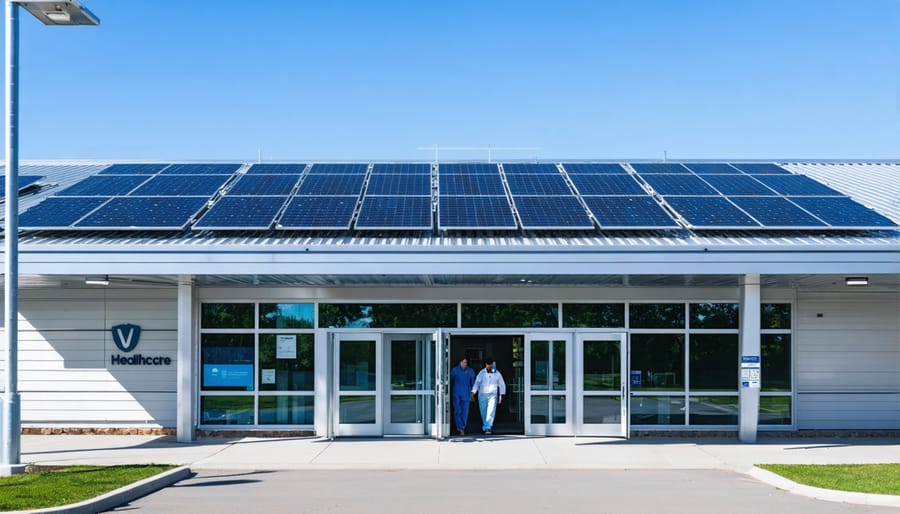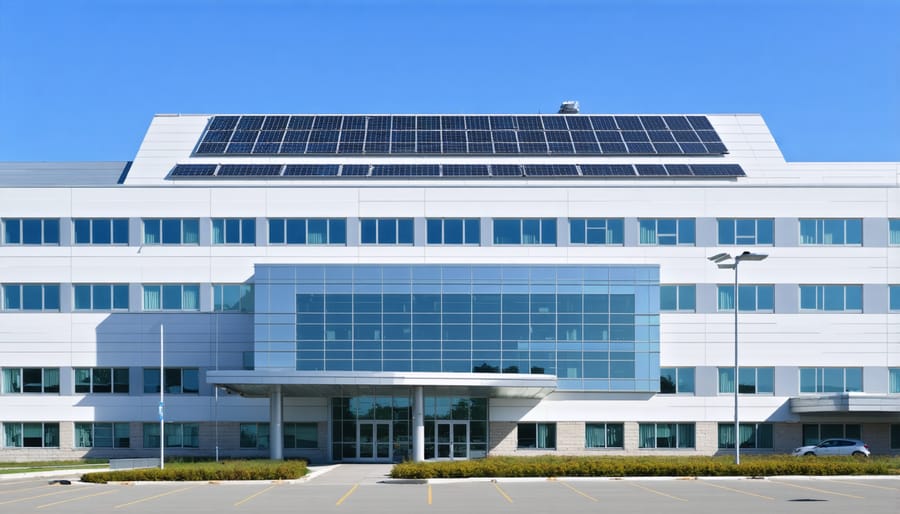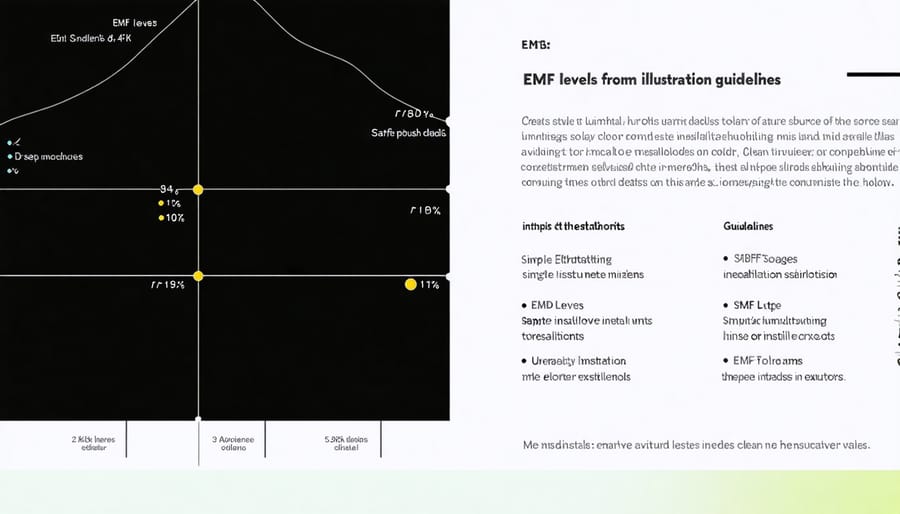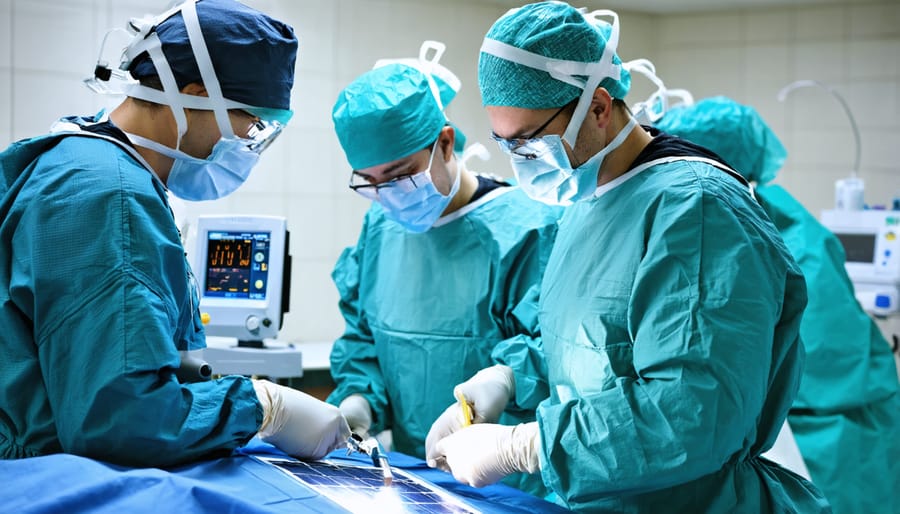Solar-Powered Healthcare: Separating Safety Facts from Fiction

The integration of solar power in healthcare facilities demands rigorous safety protocols to protect both patients and staff. While solar energy systems present minimal health risks compared to conventional power sources, healthcare facilities must address three critical safety considerations: electromagnetic field (EMF) emissions from inverter systems, potential glare affecting helicopter navigation paths, and microbial growth in water-based thermal storage systems.
Recent European studies demonstrate that properly installed solar installations emit EMF levels well below the EU safety threshold of 100 μT (microtesla), with measurements typically ranging between 0.2-0.4 μT at standard operating distances. Healthcare facility managers can effectively mitigate these minimal risks through strategic inverter placement and regular monitoring protocols.
The real challenge lies not in direct health impacts, but in ensuring system integration maintains the critical power reliability that medical equipment demands. Modern solar installations, when designed according to EN 50438 standards, incorporate redundant safety features and intelligent monitoring systems that actually enhance facility power security while reducing environmental health risks associated with traditional energy sources.

The Real Health Impact of Solar-Powered Medical Facilities
Equipment Safety and Performance
Modern solar power systems are designed to operate harmoniously with medical equipment, adhering to strict European electromagnetic compatibility (EMC) standards. High-quality solar installations feature advanced inverters and monitoring systems that minimize electromagnetic interference, ensuring they don’t disrupt sensitive medical devices or hospital operations.
Research conducted by leading European healthcare facilities demonstrates that properly installed solar systems pose no significant risks to medical equipment performance. The key lies in professional installation and regular maintenance, with systems featuring proper shielding and grounding to prevent any potential interference.
Healthcare facilities utilizing solar power typically implement additional safety measures, including dedicated circuit isolation and EMC filters. These precautions ensure that critical medical equipment, from MRI machines to patient monitoring systems, continues to function optimally.
To maintain equipment safety, facility managers should conduct regular electromagnetic compatibility assessments and ensure their solar installations comply with IEC 60601-1-2 standards for medical electrical equipment. This proactive approach helps identify and address any potential interference issues before they impact healthcare operations.
Electromagnetic Fields: Facts vs. Myths
Scientific research consistently shows that electromagnetic fields (EMF) generated by solar power systems are minimal and well within established safety limits. Modern solar installations typically produce EMF levels comparable to common household appliances, and these levels decrease significantly with distance.
Studies conducted by the European Commission’s Scientific Committee on Health have found no evidence linking properly installed solar power systems to adverse health effects from EMF exposure. The electromagnetic fields generated by solar inverters and wiring are generally less than those produced by kitchen appliances or mobile phones.
To put this in perspective, measurements taken at solar installations across Europe demonstrate that EMF levels at a distance of one meter from solar equipment are typically less than 0.1% of the exposure limits set by the International Commission on Non-Ionizing Radiation Protection (ICNIRP).
While concerns about EMF exposure are understandable, the scientific consensus supports the safety of solar power systems when installed according to European standards and regulations. Regular maintenance and professional installation ensure that any electromagnetic emissions remain well within established safety parameters.

Safety Standards and Certifications
Medical Facility Compliance
Healthcare facilities implementing solar power systems must adhere to stringent European medical facility regulations and safety standards. These installations require specialized considerations beyond standard commercial solar deployments, particularly concerning electromagnetic compatibility (EMC) with sensitive medical equipment.
Key requirements include maintaining uninterrupted power supply for critical care areas, implementing robust backup systems, and ensuring solar installations don’t interfere with emergency power systems. Facilities must conduct comprehensive EMC assessments before installation and maintain regular monitoring protocols.
The European Medical Device Regulation (MDR) and IEC 60601-1-2 standards outline specific requirements for electrical systems in healthcare environments. Solar installations must incorporate appropriate shielding and grounding systems to prevent electromagnetic interference with life-support equipment and diagnostic instruments.
Additional considerations include maintaining sterile environments during installation, scheduling works to minimize disruption to patient care, and implementing fail-safe mechanisms. Facilities must also document all solar system components and maintain detailed maintenance records to ensure compliance with healthcare accreditation requirements.
Quality Assurance Protocols
Regular quality assurance protocols are essential for maintaining the safety and efficiency of solar power installations. These protocols typically include comprehensive testing of electrical systems, structural integrity assessments, and performance monitoring. European facilities must adhere to IEC 61730 safety standards and conduct quarterly inspections of all solar components, including panels, inverters, and wiring systems.
Maintenance teams should perform visual inspections monthly, checking for physical damage, loose connections, and signs of wear. Thermal imaging scans are conducted bi-annually to detect potential hotspots or electrical anomalies that could pose safety risks. Data monitoring systems continuously track performance metrics, alerting operators to any deviations from normal operation parameters.
Documentation of all testing procedures and results is mandatory, with records maintained for at least five years. Staff training programmes ensure that maintenance personnel are qualified to perform these checks safely and effectively. Emergency response protocols must be clearly defined and regularly updated, with annual drills conducted to maintain preparedness.
These rigorous quality assurance measures help minimise health and safety risks while maximising system reliability and performance.
Benefits for Patient Care
Reliable Power Supply
Solar power installations in healthcare facilities are increasingly recognized for their role in ensuring uninterrupted medical services. Modern solar energy systems, when properly integrated with reliable backup power systems, provide a dependable energy source that supports critical medical equipment and essential hospital operations.
These systems typically incorporate advanced battery storage solutions and intelligent power management technology, enabling seamless switching between solar, grid, and backup power sources. This redundancy ensures that vital medical equipment remains operational during grid outages or adverse weather conditions, directly contributing to patient safety and care quality.
European healthcare facilities implementing solar power solutions have reported significant improvements in their energy security. For instance, hospitals equipped with solar installations maintain stable power supply for essential services like operating theaters, intensive care units, and diagnostic equipment. The integration of smart monitoring systems provides real-time oversight of power generation and consumption, allowing facility managers to optimize energy distribution across different hospital departments.
Moreover, modern solar installations include sophisticated surge protection and power conditioning features that shield sensitive medical equipment from voltage fluctuations, ensuring both equipment longevity and reliable operation. This comprehensive approach to power management has made solar energy an increasingly attractive option for healthcare facilities seeking to enhance their operational resilience while maintaining the highest standards of patient care.

Environmental Health Benefits
The implementation of solar power systems in healthcare facilities brings substantial environmental health benefits that extend beyond immediate cost savings. By reducing reliance on fossil fuels, solar-powered medical facilities significantly decrease their carbon footprint and contribute to improved air quality in surrounding communities.
Studies across European healthcare centres show that transitioning to solar power can reduce a facility’s carbon emissions by up to 80%, depending on the installation size and energy consumption patterns. This reduction in greenhouse gas emissions directly correlates with decreased rates of respiratory ailments in nearby residential areas.
Particularly noteworthy is the impact on air quality around medical facilities. Traditional power generation methods often release particulate matter and harmful gases into the atmosphere. Solar power eliminates these local emissions, creating a cleaner environment for patients, staff, and visitors. This is especially crucial for facilities treating respiratory conditions, where air quality plays a vital role in patient recovery.
Furthermore, solar-powered healthcare facilities contribute to regional air quality improvement targets set by European environmental agencies. The cumulative effect of multiple facilities adopting solar power creates significant positive impact zones, where reduced emissions lead to measurable improvements in local air quality indicators.
This environmental benefit aligns perfectly with healthcare’s fundamental mission of promoting public health and well-being, making solar power an increasingly attractive option for forward-thinking medical facilities across Europe.
Risk Mitigation Strategies
To ensure optimal safety in solar-powered healthcare facilities, implementing robust risk mitigation strategies is essential. Following established energy management best practices helps maintain both system efficiency and workplace safety.
Regular maintenance inspections should be conducted by certified professionals, focusing on electrical components, mounting structures, and backup systems. Healthcare facilities should establish clear protocols for emergency situations, including power outages and system malfunctions, with detailed response procedures for staff.
Proper isolation and shielding of electrical components is crucial, particularly in areas where sensitive medical equipment operates. Installing surge protection devices and implementing redundant grounding systems helps protect both equipment and personnel from electrical hazards.
Staff training programmes should cover basic system operation, safety protocols, and emergency procedures. This includes recognising warning signs of potential system issues and understanding proper shutdown procedures when necessary.
Documentation and monitoring systems should track performance metrics and maintenance records, enabling quick identification of potential risks. Healthcare facilities should also maintain updated safety certificates and comply with all relevant European safety standards and regulations.
Integration of modern monitoring systems with automated alerts helps detect anomalies early, reducing the risk of system failures that could impact patient care. Regular safety audits ensure continuous compliance with evolving healthcare facility requirements and solar energy standards.
Scientific research consistently demonstrates that solar power technology, when properly installed and maintained according to European safety standards, poses minimal health risks to users and operators. The occasional concerns about electromagnetic fields and material toxicity have been thoroughly addressed through rigorous testing and advanced manufacturing processes. As the solar industry continues to evolve, technological innovations are further enhancing safety measures while improving efficiency. Looking ahead, the integration of smart monitoring systems and automated maintenance protocols will provide even greater safety assurances. For European homeowners and businesses considering solar installation, the health and safety benefits far outweigh any potential risks, especially when compared to traditional energy sources. The future of solar power promises not only sustainable energy generation but also increasingly safer and more reliable systems that contribute to both environmental and public health.
Leave a Reply